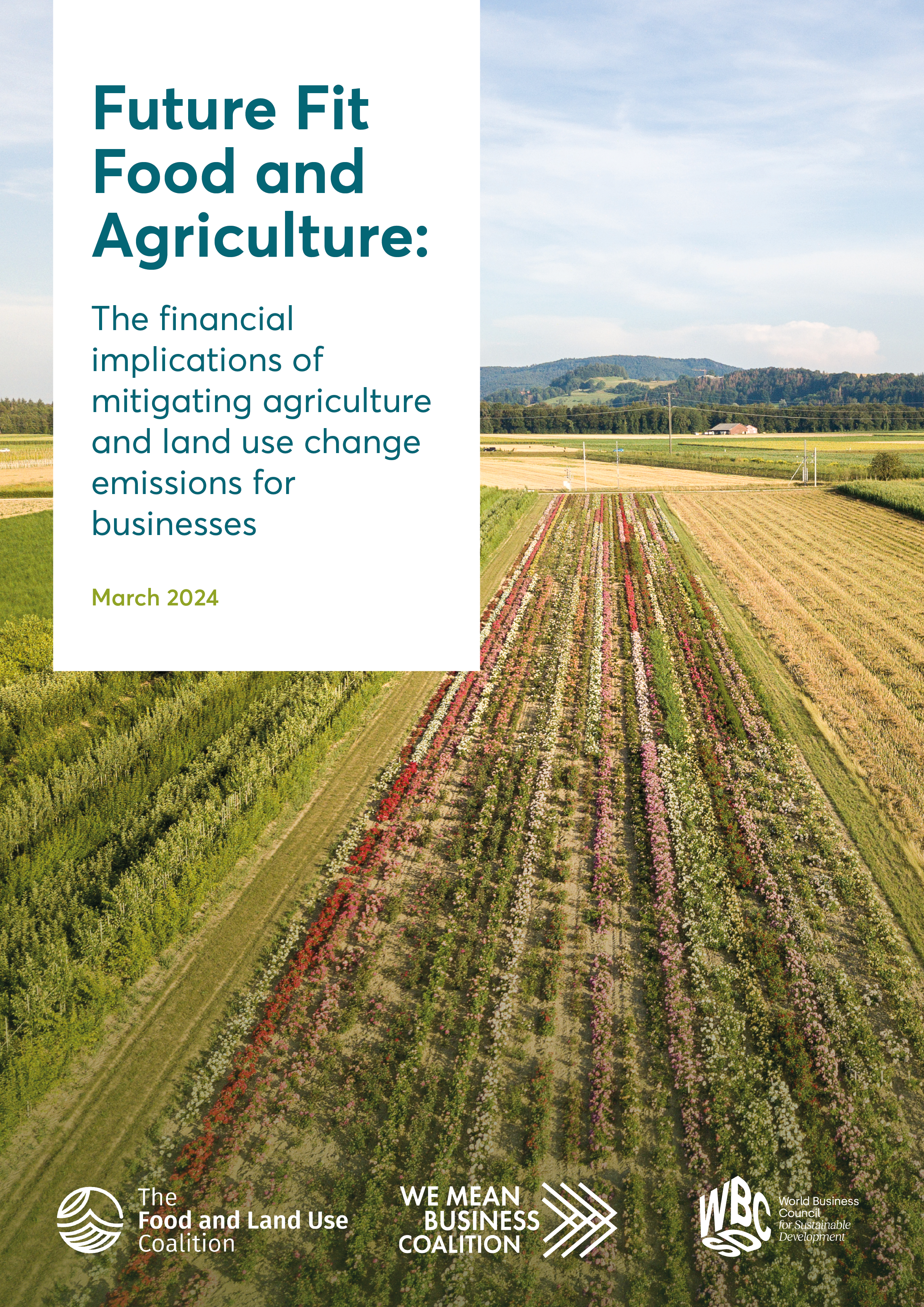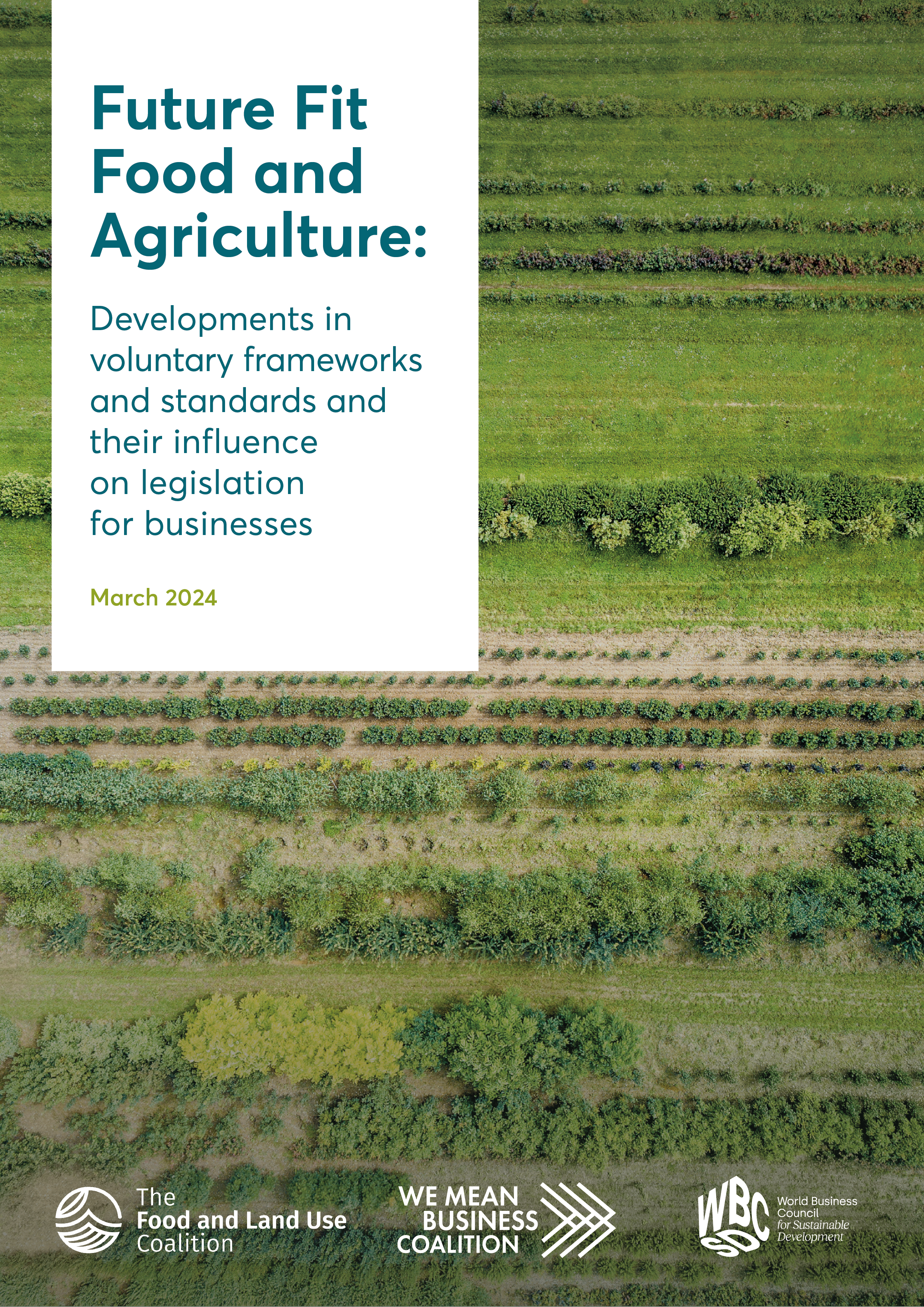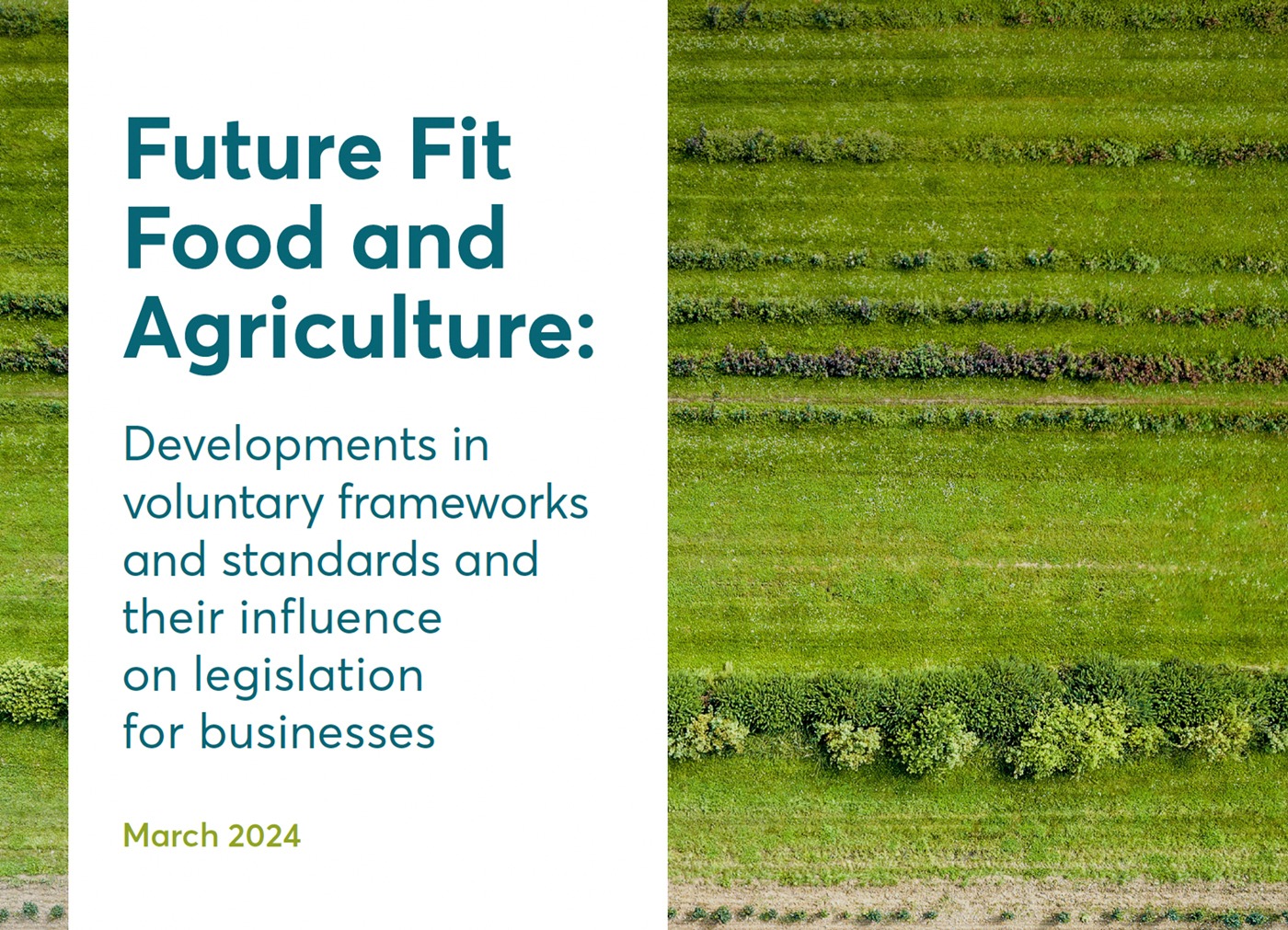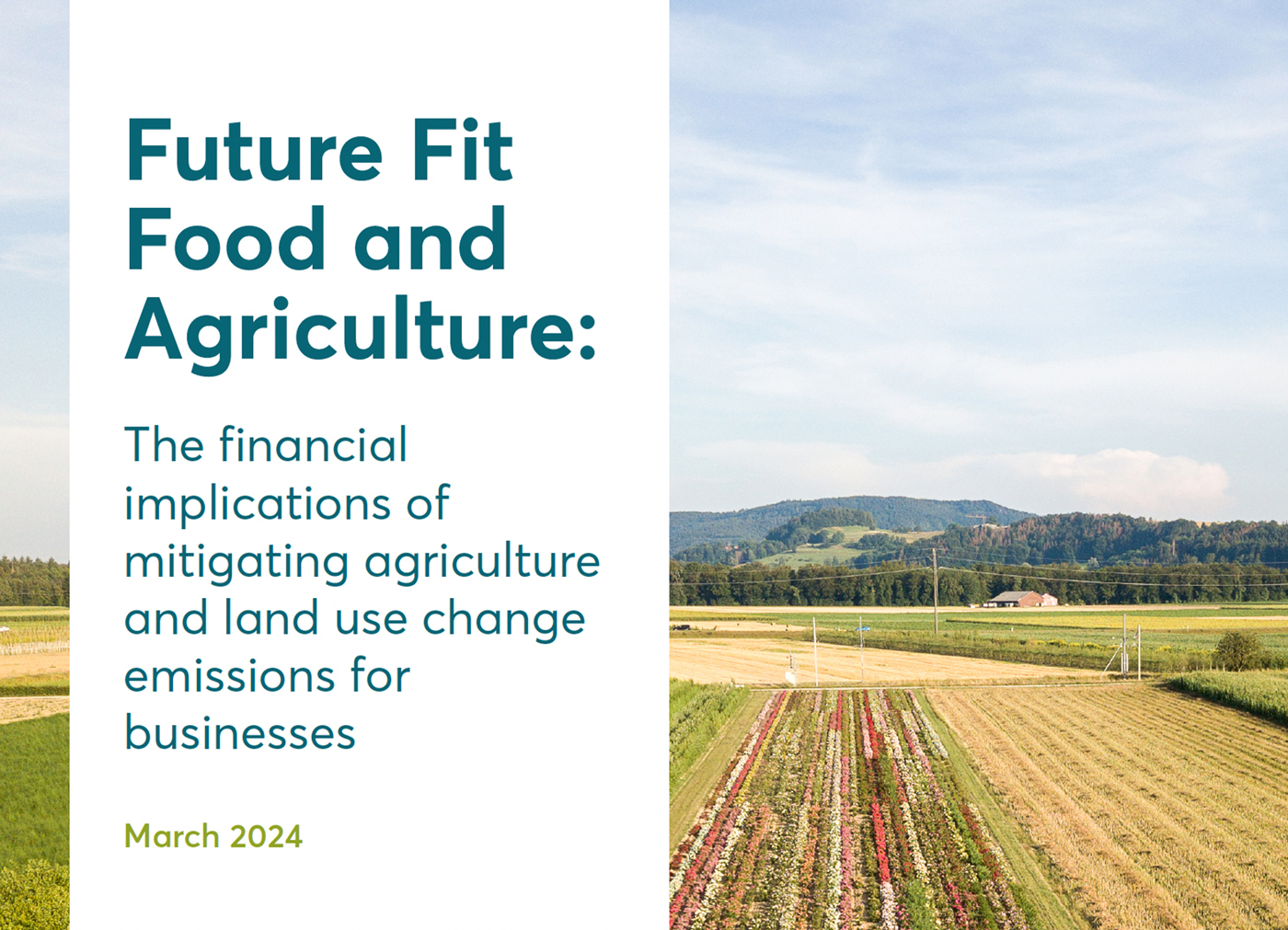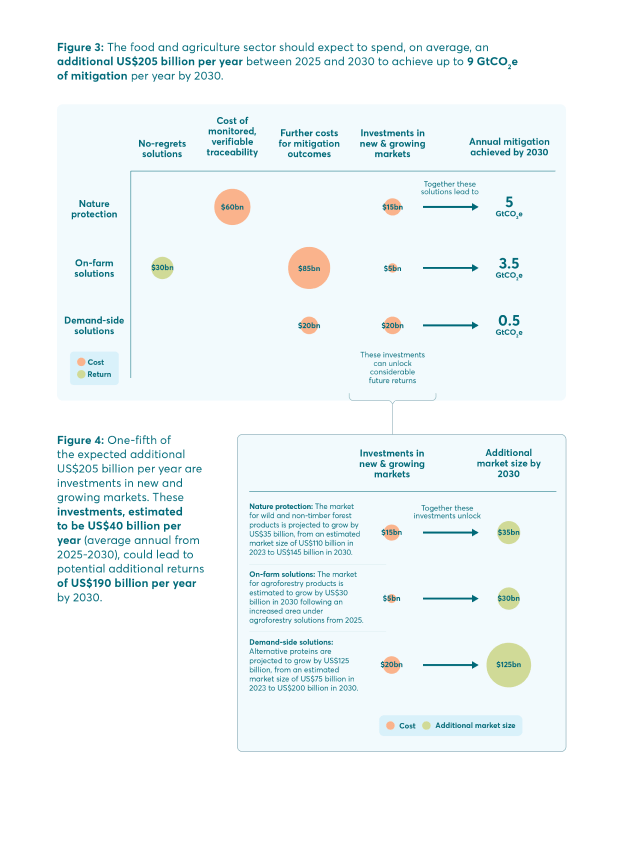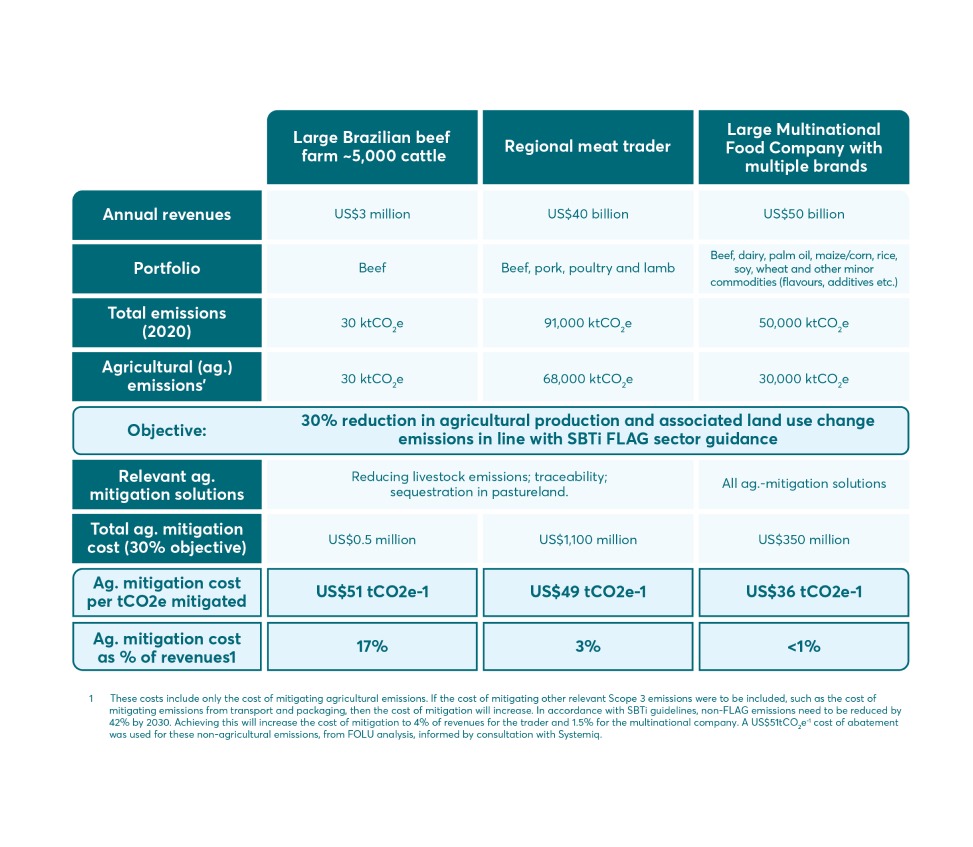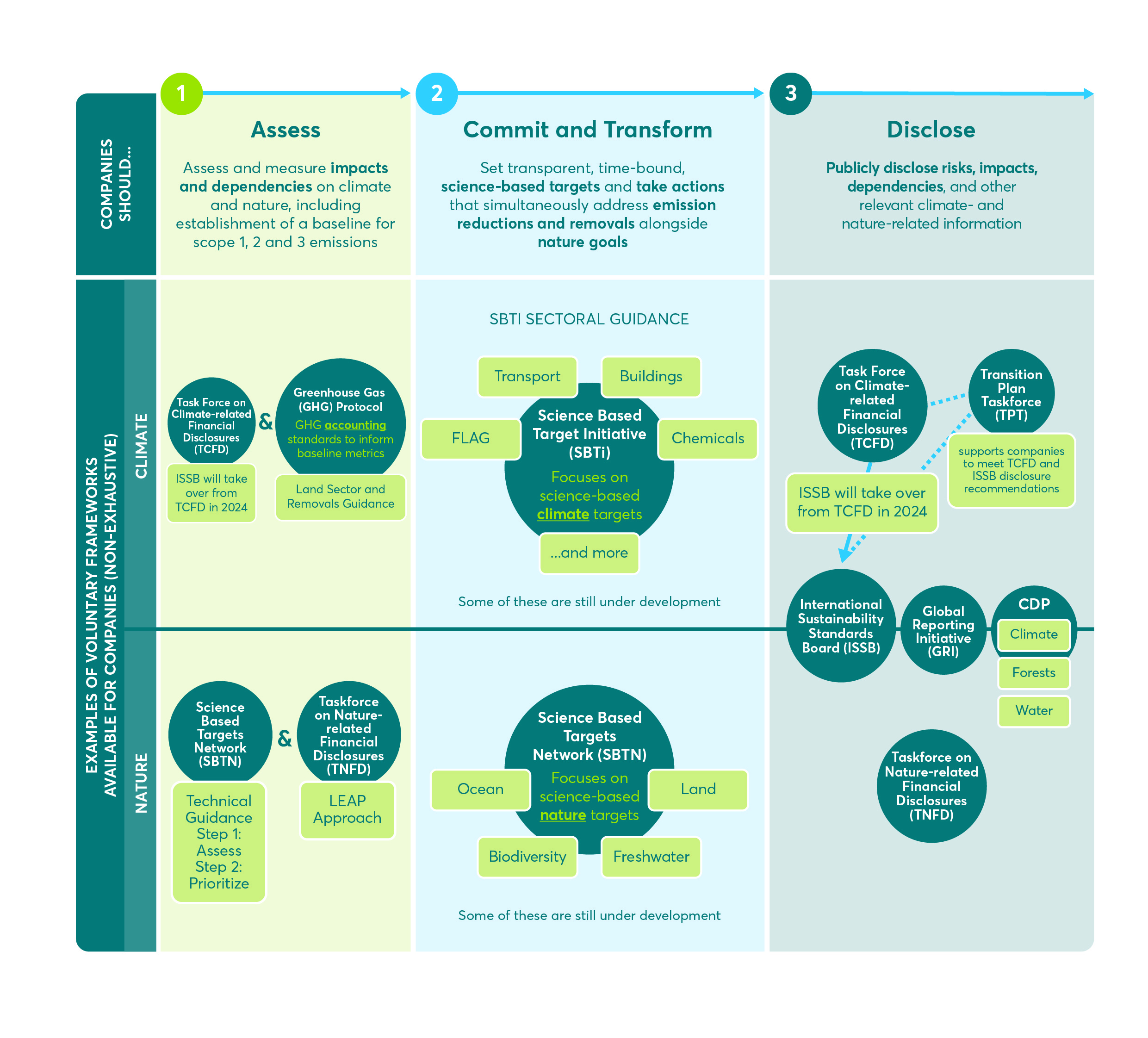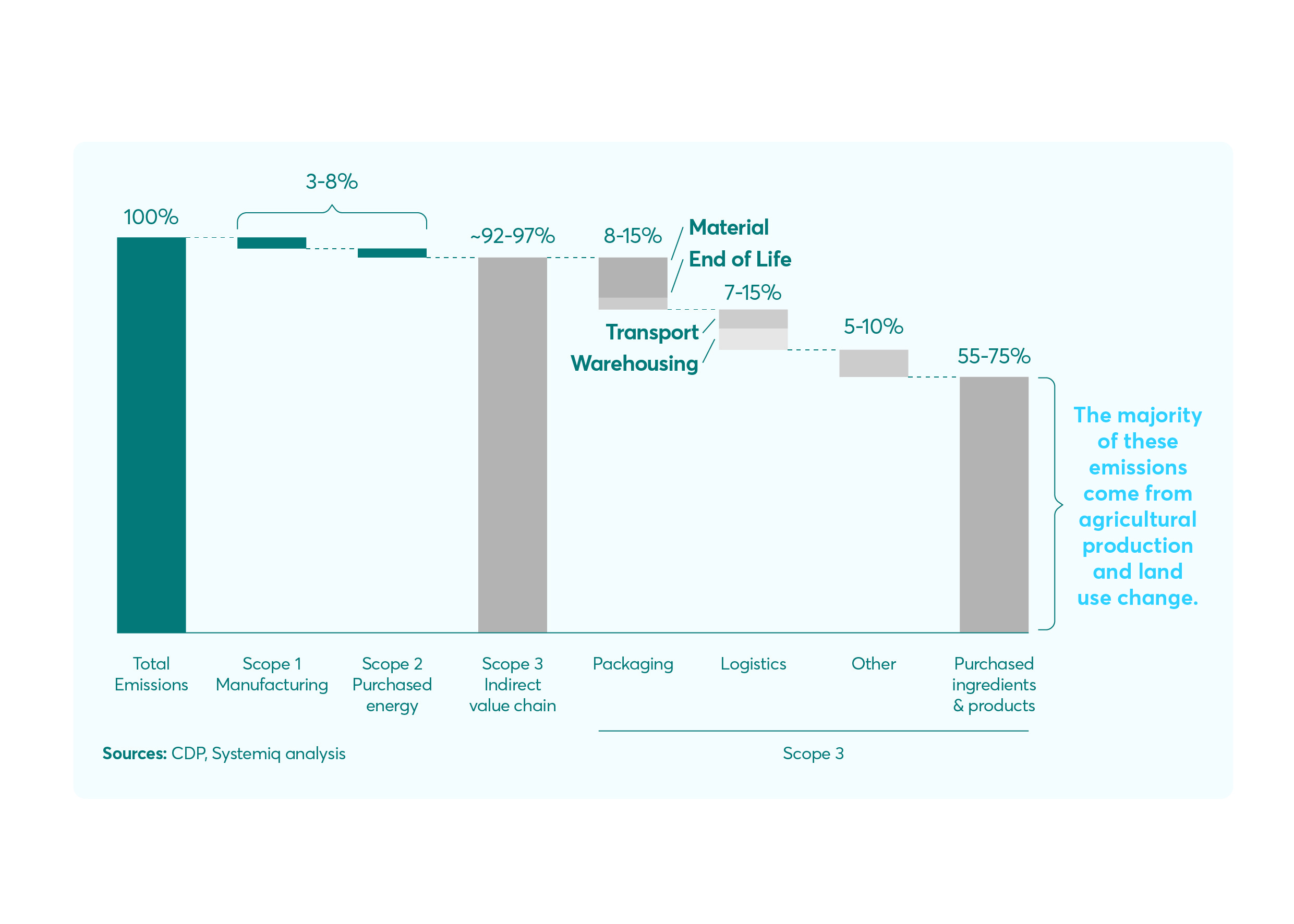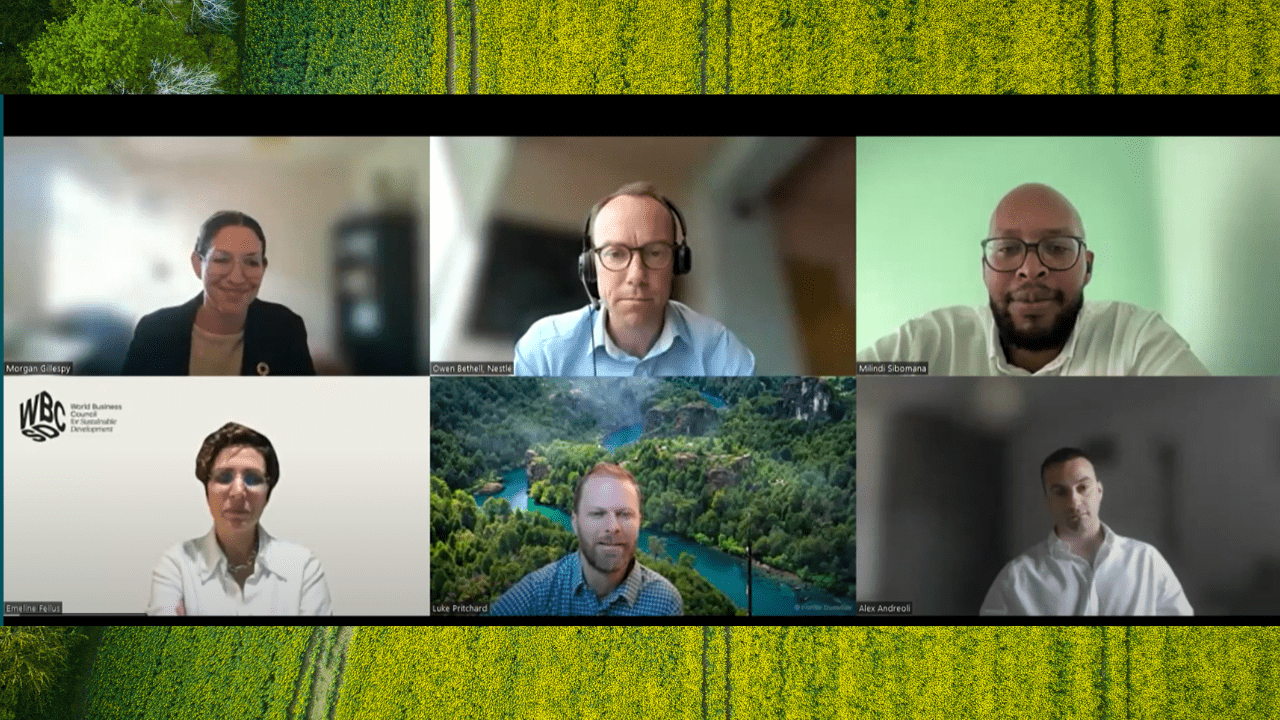US
$205bn
per year needed from the food sector to mitigate half of global food system emissions
Introduction
Dive into this report series highlighting the need for food and agriculture companies to rapidly adapt to changing sustainability regulation and exploring the costs and benefits of mitigating the largest portion of food sector emissions. The analysis shows how investments of US $205bn per year between 2025-2030, or less than 2% of food sector revenues, could mitigate nearly half of global food system emissions and unlock many other benefits.
½
of total global food system emissions come from agriculture land use change within company value chains
Webinar
Key findings
1/2
of global food system emissions come from agricultural production and land use change in company value chains
$205bn
per year needed from the food sector to mitigate ½ of global food system emissions & unlock other benefits
<2%
of the food sector’s annual revenues needed to mitigate 9 GtCO2e of emissions
$30bn
per year could be saved by investing in some on-farm mitigation solutions
$190bn
per year in potential additional revenues by investing in new and emerging markets

“By developing a credible corporate nature strategy, approved at the most senior level, a business is more likely to deliver concrete actions to halt and reverse biodiversity loss by 2030, and meet increasingly stringent regulatory reporting requirements on nature.”
Eva Zabey
CEO, Business for Nature Coalition

“China has huge potential in advancing a nature positive and 1.5C aligned food and agriculture sector by 2030. By scaling global cooperation, overseas investments and technology transfer, the country can contribute to prosperous agrifood markets and value chains that benefit both humanity and the planet alike.”
Fengwei Liu
China Director, the Food and Land Use Coalition (FOLU)

“Transitioning to a future fit food system will require companies to mobilize equitable investments and fair partnerships with farmers. This research highlights that the capital needed to drive that transformation is not only within reach, but will also pay dividends to early movers.”
Luke Pritchard
Deputy Director, Nature Based Solutions, We Mean Business Coalition

“With a 75% share in global food system emissions, companies can and must play a major role in the battle against climate change. To deliver on net-zero, the food sector should radically rethink how it partners with farmers and other key value chain actors to ensure that the costs, risks and overwhelming benefits of climate mitigation are shared equitably.”
Jayahari KM
Country Coordinator, the Food and Land Use Coalition India

“Food system transformation is a central solution to climate change and agrifood companies have a critical role to play. To meet net-zero targets, businesses must take concerted and ambitious action to de-risk the transition for producers and ensure the costs and benefits of mitigation are shared equitably across the value chain.”
Diane Holdorf
Executive Vice President, World Business Council for Sustainable Development

“To achieve net-zero, agriculture must become a carbon sink. This means we must transition to nature-based farming. To finance this we need to upend value chains and push capital and profits upstream to the farms and farmers themselves.”
Morten Rossé
Head of Nature and Climate, holistiQ Investment Partners, Lombard Odier Investment Mangers

“Food and agriculture companies are facing a choice. Those striving to deliver ambitious sustainability strategies today, in close collaboration with farmers in their supply chain, will likely enjoy lower costs, stronger returns and greater agility in the face of advancing sustainability regulation. Those that stall won’t just fail to deliver on climate and nature commitments, they will face higher costs and higher supply chain risks in the long term.”
Morgan Gillespy
Executive Director, the Food and Land Use Coalition (FOLU)

“Companies must urgently act across the food and agricultural value chain to achieve net zero by 2050. Small-scale producers are crucial in this process, thus supporting and engaging with them is essential for effective mitigation and resilient supply chains.”
Carla Hommes
Food Transformation Research Lead, World Benchmarking Alliance

“The food sector will incur some of the biggest impacts of climate change. Simultaneous climate mitigation and adaptation will be essential to address these. For this transition to be just, shared responsibility and shared risk approaches must be deployed across the supply chain while respecting and supporting farmers’ and smallholders’ land and carbon rights as they adopt new practices.”
Martha Stevenson
Senior Director, Forests Research & Strategy, World Wildlife Fund

“Transitioning to regenerative agricultural systems is essential for meeting our global climate and biodiversity targets. To enable this, we must incentivize the transition to agricultural systems that are both climate-smart and support prosperity for rural communities. These reports demonstrate the need for companies across the food and agricultural sector to increase their engagement and investment in this global transition. Establishing science-based nature and biodiversity targets is an essential step in meeting these needs.”
Bambi Semroc
Senior Vice President, Center for Sustainable Lands and Waters at Conservation International

“We are increasingly seeing policymakers establish mandatory requirements for companies to protect nature through regulations such as the EU Regulation on Deforestation-Free Products and the proposed EU Nature Restoration Law. Voluntary standards such as the Climate Bonds Standard and Criteria are valuable tools for companies to understand and implement Paris-aligned decarbonisation and nature protection measures, and for investors to identify ambitious companies and investments to finance.”
Rachel Hemingway
Head of Transitions, Climate Bonds Initiative

“Companies taking voluntary environmental action are raising corporate ambition levels and shaping future regulation. Through science-based targets, food and agriculture companies can take holistic action across climate and nature, halting not just deforestation but also the conversion of all natural lands in their supply chains, and driving the much-needed transformation of our food and land use practices.”
Erin Bilman
Executive Director, Science-Based Targets Network (SBTN)

“Our food system lies at the heart of the climate challenge, yet it is farmers who hold the key to solutions sought by agrifood businesses. Companies must urgently address the stark inequity in transition costs for farmers, to meet their own emissions reduction targets. Our work on the Global Farm Metric demonstrates, you cannot isolate climate impact from nature or overlook the food system’s effects on communities that it serves. Businesses must go beyond current mandatory reporting and adopt a holistic approach to rewarding farmers, that recognizes the interconnectedness between climate, nature and social impacts.”
Adele Jones,
Executive Director, Sustainable Food Trust

“The new reports of the Future Fit Food and Agriculture series from FOLU, WBCSD and We Mean Business Coalition highlight that agrifood companies, governments and farmers must collaborate directly to implement solutions at scale. Together, we can innovate and transform our food system challenges into opportunities.”
Feike Sijbesma,
Chair, Philips, Former CEO, DSM

Luke Pritchard
Deputy Director, Nature Based Solutions, We Mean Business Coalition
“Transitioning to a future fit food system will require companies to mobilize equitable investments and fair partnerships with farmers. This research highlights that the capital needed to drive that transformation is not only within reach, but will also pay dividends to early movers.”

Fengwei Liu
China Director, the Food and Land Use Coalition (FOLU)
“China has huge potential in advancing a nature positive and 1.5C aligned food and agriculture sector by 2030. By scaling global cooperation, overseas investments and technology transfer, the country can contribute to prosperous agrifood markets and value chains that benefit both humanity and the planet alike.”

Eva Zabey
CEO, Business for Nature Coalition
“By developing a credible corporate nature strategy, approved at the most senior level, a business is more likely to deliver concrete actions to halt and reverse biodiversity loss by 2030, and meet increasingly stringent regulatory reporting requirements on nature.”

Jayahari KM
Country Coordinator, the Food and Land Use Coalition India
“With a 75% share in global food system emissions, companies can and must play a major role in the battle against climate change. To deliver on net-zero, the food sector should radically rethink how it partners with farmers and other key value chain actors to ensure that the costs, risks and overwhelming benefits of climate mitigation are shared equitably.”

Bambi Semroc
Senior Vice President of the Center for Sustainable Lands and Waters at Conservation International
“ransitioning to regenerative agricultural systems is essential for meeting our global climate and biodiversity targets. To enable this, we must incentivize the transition to agricultural systems that are both climate-smart and support prosperity for rural communities. These reports demonstrate the need for companies across the food and agricultural sector to increase their engagement and investment in this global transition. Establishing science-based nature and biodiversity targets is an essential step in meeting these needs.”

Morgan Gillespy
Executive Director, the Food and Land Use Coalition (FOLU)
“Food and agriculture companies are facing a choice. Those striving to deliver ambitious sustainability strategies today, in close collaboration with farmers in their supply chain, will likely enjoy lower costs, stronger returns and greater agility in the face of advancing sustainability regulation. Those that stall won’t just fail to deliver on climate and nature commitments, they will face higher costs and higher supply chain risks in the long term.”

Morten Rossé
Head of Nature and Climate, holistiQ Investment Partners, Lombard Odier Investment Mangers
“To achieve net-zero, agriculture must become a carbon sink. This means we must transition to nature-based farming. To finance this we need to upend value chains and push capital and profits upstream to the farms and farmers themselves.”

Diane Holdorf
Executive Vice President, World Business Council for Sustainable Development
“Food system transformation is a central solution to climate change and agrifood companies have a critical role to play. To meet net-zero targets, businesses must take concerted and ambitious action to de-risk the transition for producers and ensure the costs and benefits of mitigation are shared equitably across the value chain.”

Carla Hommes
Food Transformation Research Lead, World Benchmarking Alliance
“Companies must urgently act across the food and agricultural value chain to achieve net zero by 2050. Small-scale producers are crucial in this process, thus supporting and engaging with them is essential for effective mitigation and resilient supply chains.”

Martha Stevenson
Senior Director, Forests Research & Strategy, World Wildlife Fund
“The food sector will incur some of the biggest impacts of climate change. Simultaneous climate mitigation and adaptation will be essential to address these. For this transition to be just, shared responsibility and shared risk approaches must be deployed across the supply chain while respecting and supporting farmers’ and smallholders’ land and carbon rights as they adopt new practices.”

Rachel Hemingway
Head of Transitions, Climate Bonds Initiative
“We are increasingly seeing policymakers establish mandatory requirements for companies to protect nature through regulations such as the EU Regulation on Deforestation-Free Products and the proposed EU Nature Restoration Law. Voluntary standards such as the Climate Bonds Standard and Criteria are valuable tools for companies to understand and implement Paris-aligned decarbonisation and nature protection measures, and for investors to identify ambitious companies and investments to finance.”

Erin Bilman
Executive Director, Science-Based Targets Network (SBTN)
“Companies taking voluntary environmental action are raising corporate ambition levels and shaping future regulation. Through science-based targets, food and agriculture companies can take holistic action across climate and nature, halting not just deforestation but also the conversion of all natural lands in their supply chains, and driving the much-needed transformation of our food and land use practices.”

Adele Jones,
Executive Director, Sustainable Food Trust
“Our food system lies at the heart of the climate challenge, yet it is farmers who hold the key to solutions sought by agrifood businesses. Companies must urgently address the stark inequity in transition costs for farmers, to meet their own emissions reduction targets. Our work on the Global Farm Metric demonstrates, you cannot isolate climate impact from nature or overlook the food system’s effects on communities that it serves. Businesses must go beyond current mandatory reporting and adopt a holistic approach to rewarding farmers, that recognizes the interconnectedness between climate, nature and social impacts.”
Technical Appendix
How Can Businesses Secure a More Sustainable, Equitable and Resilient Future for the Food Sector?
Podcast
In this podcast, Climate Bonds interviews key authors of these reports to dive deeper into the costs, benefits, and essential actions businesses need to take today to build more equitable, resilient, and sustainable food and land use systems.
Media and other Resources
Food and agriculture firms are facing a choice: How investing a fraction of revenues could eradicate half the food industry’s emissions
$205 billion per year needed from the agrifood sector to mitigate half of global food system emissions
For general enquiries:
Media contacts:
Sophie Mongalvy,
Communications & Marketing Director, FOLU Global
Klara Nilsson,
Communications & Marketing Manager, FOLU Global
Sign up to our newsletter
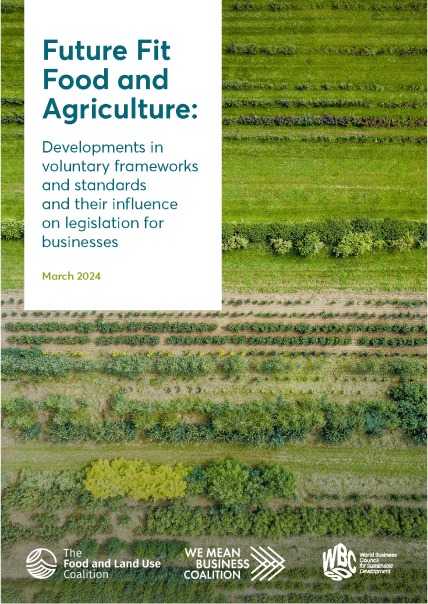
Developments in voluntary frameworks
and standards and their influence
on legislation for businesses
Discover how companies in the food sector can better navigate voluntary frameworks and standards for climate and nature and their growing influence on sustainability regulation.
Crucially, our findings highlight that businesses setting and implementing ambitious climate and nature strategies today will be better prepared for future sustainability regulation, facing fewer compliance risks and experiencing less disruption in their supply chains.
Ambitious companies can not only leverage established and emerging voluntary standards to get ahead of the game, but they can and should also seize the opportunity to advocate for harmonized standards and regulation, which will accelerate the food sector’s transition to a sustainable future.
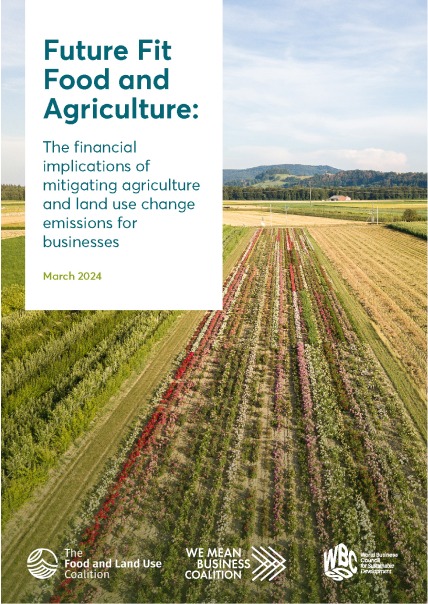
The financial implications of mitigating agriculture and land use change emissions for businesses
With climate and nature regulation increasingly on the horizon, explore what it will take to mitigate agriculture and land-use-change emissions within company value chains (estimated at 10 GtCO2e in 2030) which account for nearly half of total global food system emissions.
Our findings show that investment from the food sector of approximately US $205 billion per year between 2025 and 2030 could mitigate up to 9 GtCO2e annually by 2030. While significant, these costs represent less than 2% of total projected food sector revenues and come with other benefits including access to new and growing markets, some on farm savings and improved supply chain resilience.
This report highlights that the burden of mitigation varies depending on where actors sit along the value chain. A critical challenge is that the costs are currently projected to land most heavily on farmers, who are the least able to pay. Overcoming this inequity requires companies to reassess how they partner with actors in the value chain, particularly farmers, and how they engage with policymakers to accelerate action.

